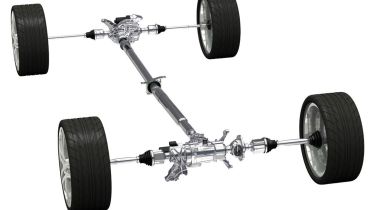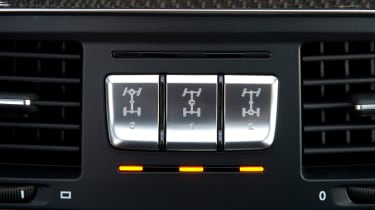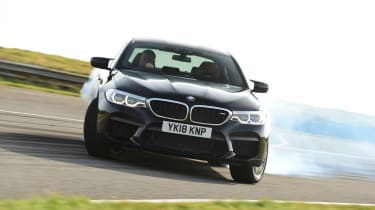What is a limited slip differential?
A limited-slip differential, or LSD, helps get your car's power to the road. We explain how

If you're an admirer of sports cars or 4x4s, then there's a reasonable possibility you might have heard of the limited-slip differential. This piece of kit, abbreviated to LSD for short, is part of a car's drive system, and it's designed to help the engine put its power to the road more efficiently, to the benefit of a car's performance and handling.
In basic terms, the limited-slip diff does what it says, as it's a device that limits the amount of wheelspin when the driven wheels lose grip when power is applied. The LSD does this by redistributing engine power to the wheels with the most grip, either with a mechanical system, with electronics or through a combination of the two.
• What is 4WD? All-wheel drive systems explained
The chief benefit of fitting a car with an LSD is to improve the way it drives, although it's also a useful safety feature, because it offers more control over a car's power delivery. You'll often find a limited-slip diff fitted to performance cars that have a a lot of power which they would otherwise struggle to get to the road. Other applications include fitting them to four-wheel-drive cars that are likely to venture off-road and need the extra traction that these diffs can help to create.
Mechanical diffs are expensive to develop and fit, which is why you'll often only find them on more expensive performance models, and hot hatchback versions of compact family cars. However, with the advance of in-car electronics, some manufacturers now offer e-diffs, which do a similar job to an LSD by using wheel speed sensors that tell the car's electronics to apply the brakes to a spinning wheel in an effort to control a car's power delivery.
Want to know more? Read on to find out about the history of limited-slip diffs, the various types of diff and how they work.
History of the limited-slip diff
Like many road car developments, the origins of the LSD can be traced back to motor racing. In the 1930s, Ferdinand Porsche commissioned German engineering firm ZF to create a differential that would help to reduce wheelspin in Auto Union's Grand Prix cars, as their vast power outputs easily overcame the grip provided by the narrow tyres of the time.
Subsequently, the benefits of this type of diff were exploited in off-road vehicles, but the limited-slip differential gained prominence again in the 1960s and the US Muscle Car era. These machines were built during a performance car arms race between the US manufacturers American Motors, Chrysler (and its brands Dodge and Plymouth), Ford (plus Mercury) and General Motors (with its Buick, Chevrolet, Oldsmobile and Pontiac brands).
• How to change a car battery and choose the right battery for your car
But with escalating power outputs from their V8 engines and not much sophistication in their drivetrains, the limited-slip diff (also known as a 'posi', or positraction, diff) helped cars gain traction where others would simply spin it away in a cloud of tyre smoke, and it became a desirable box to tick when specifying your muscle car.
Since then, the limited-slip diff has become more sophisticated and complemented by more advanced electronic control systems, and there are different types of LSD on offer depending on what you need them for. The mechanical diff is still a desirable extra on rear-wheel-drive sports cars, and well developed systems will still offer better responses than any electronic alternative.

On front-wheel-drive hot hatchbacks, the LSD helps to minimise undesirable torque steer as the front wheels have to cope with steering as well as putting the power down, while the introduction of more advanced electronics helps the front wheels to cope with power outputs that were unheard of only a decade ago. For four-wheel-drive cars, the limited-slip diff has a specific task in sending power to the corner of the car with the most grip, and the most sophisticated systems can be used in conjunction with locking diffs to boost a car's off-road ability.
How does a limited-slip diff work?
The principle of the limited-slip differential is that it offers more control over power delivery than a conventional 'open' diff. An open diff uses gears to ensure that the wheels turn at different speeds when going round corners, but when there is lots of power being delivered, it's easy for an open diff to be overcome by its delivery. When power arrives at the wheels, it looks for the path of least resistance, which in this instance means the tyre with the least amount of grip. If you're heavy with the throttle in a powerful car, this can mean all the power evaporates in a cloud of smoke as the unloaded tyre spins away while the other tyre continues to grip.
Add an LSD, and extra mechanisms – usually in the form of a clutch assembly, cams, or even a viscous fluid system that's part of the diff – counter this natural flow of power to redistribute the engine's torque to the wheels with the most grip. The result is reduced wheelspin for the unloaded tyre, and the car's power is put to the road more effectively, which will boost grip and therefore cornering and acceleration performance.
• Driverless cars: everything you need to know
There are different types of limited-slip diff available, and which one a car uses will depend on the drive system it uses. On rear-wheel-drive and 4WD cars, a 2-way LSD might be used. This means that the LSD will have an effect when applying power and also when slowing down, meaning a consistent feel to the car.
A one-way LSD is better suited to a front-wheel-drive car, because this will only have a limiting effect when accelerating. When slowing, the LSD is inactive, which helps with cornering off the power because a 2-way diff has a tendency to introduce understeer to the drive system.
In between these two is a 1.5-way LSD. This offers an LSD effect under acceleration and when slowing, but the amount of slip isn't the same in both directions, so there's less effect in one direction than in the other. This can be more useful than a one-way LSD because it still enables a car to use engine braking when slowing down.

Another type of LSD is the torque-sensing differential. Otherwise known by its product name of ‘Torsen’ diff, this is a special type of differential that's used by four-wheel-drive cars to split power between front and rear axles. One of the first production cars to use a Torsen diff was the Audi Quattro, and this system helped it to dominate in rallying in the early 1980s.
Other LSD types
In an effort to reduce manufacturing costs, some car makers have come up with alternatives to the limited-slip diff that deliver a similar effect. A viscous LSD uses thick oil to create the limited-slip effect, although this system can wear faster than a mechanical LSD, while the oil can heat up and lose its effectiveness, too.
Advances in electronics have seen car makers manage to emulate the effects of LSDs by using sensors to achieve the effect. Some systems feature a conventional diff with an LSD-style clutch pack, but its action is controlled by a computer. This can be tailored to suit requirements, including by the driver via switchable drive modes.
Another variation on this is the fully electronic diff, or e-diff. These will have a conventional open diff with no LSD components, and instead the car's electronics will rely on wheel speed sensors and the car's ABS system to detect the early stages of wheelspin and use the car's braking system to limit the torque going to the wheel that's losing traction. It's a very effective system, while an advance of this is torque vectoring, which actively distributes power to the wheels with the most grip.
Enjoyed this technical piece? Then why not read our explain-all article on ESP and ESC.
Find a car with the experts


